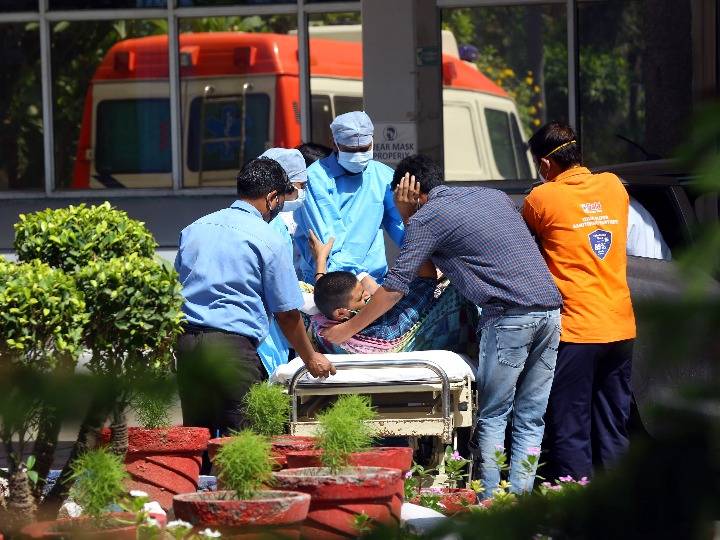
Xinhua News Agency, Beijing, April 26 (Reporter Ying Zhang) Since April, the new crown epidemic in India has rebounded rapidly, and the number of newly diagnosed cases in a single day has reached a new high, which has aroused global attention. Experts believe that the emergence and expansion of the mutated new coronavirus is one of the reasons for the rapid deterioration of the epidemic in India. So, what are the main mutated new coronaviruses that have appeared in India? What are the characteristics? How is the current spread?
According to a bulletin issued by the Ministry of Health of India at the end of March, the "Indian New Coronavirus Genomics Alliance" composed of 10 national laboratories found a new mutant virus in samples collected in Maharashtra, carrying E484Q and L452R Mutations may lead to immune escape and increased infectivity.
This mutant virus, which was originally called a "double mutant" virus by the media, has been officially named B.1.617 by the scientific community. Dr. Shahid Jamil, the dean of the Trivedi School of Biological Sciences at Ashoka University in India and a virologist, said in an exclusive interview with the Shillong Times of India that the term "double mutant" virus is not accurate enough. B. 1.617 contains a total of 15 mutations, 6 of which occur on the viral spike protein, of which 3 are more critical.
According to reports, both L452R and E484Q mutations occur in the region where the spike protein binds to the "angiotensin converting enzyme 2 (ACE2)" receptor in human cells. L452R improves the ability of the virus to invade cells, and E484Q helps Enhance the immune escape of the virus. Another mutation in the spike protein, P681R, also allows the virus to enter the cell more efficiently. The combined effect of these mutations makes the virus more infectious and can partially avoid some neutralizing antibodies.
The latest data from the Global Influenza Shared Database shows that the database received the sequencing results of B.1.617 samples as early as October 2020, and it has now spread to at least 18 countries or regions around the world. The sequencing results of more than 1,000 B.1.617 samples that have been submitted to the database are 786 from India, 317 from the United Kingdom, and 109 from the United States.
Up to now, the World Health Organization has not listed B.1.617 as a mutant virus that needs attention.
The spread of the B.1.617 mutant virus in India is worrying the outside world. However, many experts emphasized that it is not the main reason for the recent surge in the number of confirmed and death cases of the new crown in India. Dr. Rakesh Mishra, Director of the Cell and Molecular Biology Center of the Indian Council of Science and Industrial Research, said that B.1.617 only accounts for about 10% of the samples of the new coronavirus that have been sequenced in India, even in Maharashtra. It only accounts for about 30%. Although "its footprint is increasing day by day", it is only part of the reason why the epidemic has intensified. He believes that the main reason for the second wave of the epidemic in India is that the public has a lax attitude towards epidemic prevention and has not strictly followed the epidemic prevention regulations such as wearing masks and maintaining social distancing.
Dr. Vinita Barr, a visiting professor and immunologist at the Indian Institute of Science and Education, believes that B.1.617 itself does not seem to cause more serious diseases, but the rapid increase in the number of patients in India is causing the collapse of health infrastructure, which may cause death The rate rises.
There is still a lack of data and conclusions on whether B.1.617 will affect the effectiveness of the existing new crown vaccine. Dr. Jamil said that the protective efficacy of the vaccine may be reduced due to virus mutations. This situation has been observed in the Phase III clinical trials of the new crown vaccine of Johnson & Johnson and Novavax in the United States. These two vaccines are effective in preventing the original new coronavirus and the mutant virus that appeared in the United Kingdom, but they are less effective against the mutant virus that appeared in South Africa and Brazil.
According to multiple media reports, Indian researchers also found a mutant new coronavirus named B.1.618 in samples collected in West Bengal, and it is currently spreading mainly in the state. Vinod Skarya, a scientist at the Institute of Genomics and Integrative Biology of the Indian Council of Science and Industrial Research, recently said on social media that B.1.618 is a new mutant virus discovered in India, which carries a virus that can enhance the immune escape of the virus. The ability of the E484K mutation. Both the mutant virus B.1.351 that appeared in South Africa and the mutant virus P.1 that appeared in Brazil also carry the E484K mutation. Scaria said that there are still many unknowns about the ability of B.1.618 to cause secondary infections and break through the protection of the vaccine to cause infections, and more experimental data are needed to evaluate the protective efficacy of the new corona vaccine against this mutant virus.
Dr. Barr emphasized that no matter what kind of new coronavirus is targeted, “vaccinations always put you in a good position to fight the infection”.












